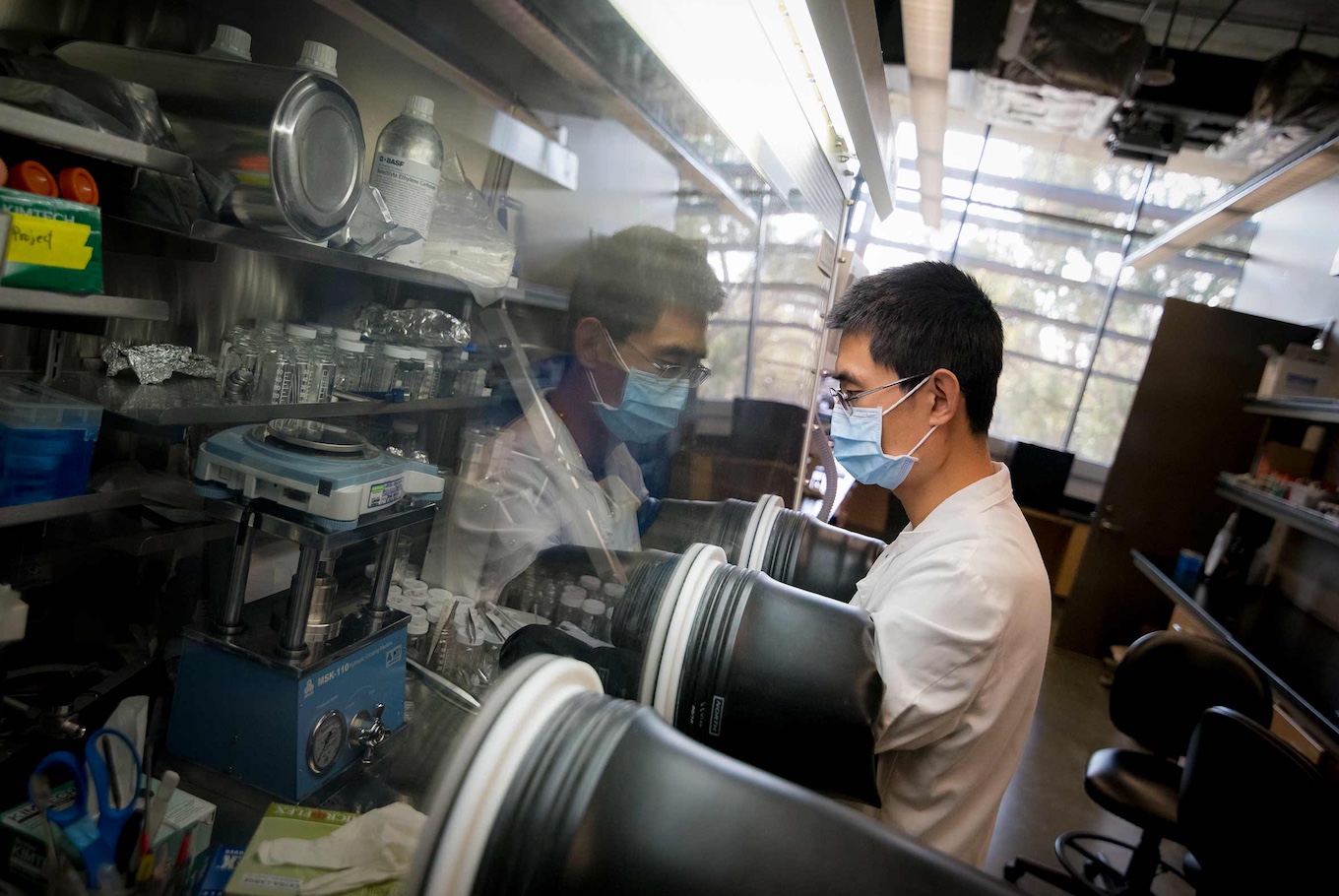Daily Business Report-May 3, 2019
Synthetic opioids, primarily the class known as fentanyls, have surpassed prescription opioids as the most common drugs involved in overdose deaths in the United States, according to the Centers for Disease Control and Prevention.
Vaccine shows lasting effects
against deadly synthetic opioids
Scripps Research
Scientists at Scripps Research Institute have developed an experimental vaccine that may one day help treat addiction to fentanyl, a highly potent opioid linked to an epidemic of overdoses and fatalities in recent years.
In research published in the latest issue of the journal Neuropsychopharmacology, the team led by Kim Janda, showed that its vaccine produced months-long results in rats, decreasing dangerous drug-taking behavior and increasing behaviors maintained by healthier non-drug alternatives—in this case, choosing food over drugs.
Synthetic opioids, primarily the class known as fentanyls, have surpassed prescription opioids as the most common drugs involved in overdose deaths in the United States, according to the Centers for Disease Control and Prevention. By developing a novel vaccine against fentanyls, Janda and his team aim to diminish the “high” that results from taking this class of drug, thereby reducing rates of addiction and relapse.
This vaccine combines a fentanyl antigen with a modified tetanus toxin, since fentanyl on its own is unable to stimulate the production of antibodies. In this way, the vaccine cocktail elicits an immune response against the fentanyl family of synthetic opioids. Janda’s team recently took a similar approach in developing a vaccine candidate to address heroin addiction.
Once the vaccine was developed, researchers at Virginia Commonwealth University School of Medicine, led by Matthew Banks, PhD, investigated its effectiveness to decrease fentanyl self-administration and increase food self-administration in male and female rats.
“More effective and readily available treatments for opioid use disorder are needed to tackle the current crisis,” the study authors say. “One strategy includes using opioid-targeted vaccines to elicit antibody production by the host’s immune system that recognize and blunt the passage of fentanyl into the brain.”
___________________

Scientists develop new production method
for seaweed chemical used in brain research
A team of scientists at Scripps Institution of Oceanography and the J. Craig Venter Institute has developed a new way to produce kainic acid, a natural seaweed neurochemical and powerful reagent used in brain research.
In a new study published April 17 in the journal Angewandte Chemie International Edition, the scientists were able to sequence the genome of a seaweed known to produce kainic acid, and they identified the enzymes responsible for production of the natural chemical. They also utilized biotechnology to develop a cheaper and more efficient way to produce the seaweed chemical in gram quantities in the lab—a major breakthrough with implications for large-scale production of kainic acid in the future.
“Because kainic acid is an important molecule still used in research today, we wanted to develop a new way to produce it,” said lead author Jonathan Chekan, a postdoctoral fellow at the Center for Marine Biotechnology and Biomedicine at Scripps Oceanography. “This biotransformation approach allows us to quickly produce kainic acid in a cheaper and more environmentally friendly way than traditional chemical synthesis.”
___________________

Lobbying Business Grows
Persuasion is a growth industry
Corporations, advocacy groups, unions, local government and others spent $87.3 million on lobbying in the first quarter of Gov. Gavin Newsom’s tenure.
Although it was a modest 3 percent bump from the first quarter of 2018, spending by lobbyist employers increased by 14 percent from the first quarter of 2017.
Lobbyist employers spent $67.5 million in the first quarter of 2011, the start of Jerry Brown’s tenure. That’s a jump of nearly 30 percent.
They spent $51.6 million in the first quarter of 2004, the start of Gov. Arnold Schwarzenegger’s tenure, almost a 70 percent increase.
Chevron and the Western States Petroleum Association, fending off more restrictions, were the top two spenders in the first quarter of 2019, at a combined $4.2 million, up from $1.5 million at the start of Brown’s tenure.
The ACLU was the third-biggest spender, at $1.1 million. It’s lobbying for legislation related to police use of force.
Capitol Advocacy, the highest-billing lobbying firm, reported $2.06 million in charges. Its clients range from a payday lender and a private prison operator, to nursing homes, police unions, retailers and Pacific Gas & Electric.
Axiom Advisors, a firm founded last year and led by one of Newsom’s political advisers, reported billings of $582,000, placing it 27th among all lobbying firms in the first quarter of 2019.
— Dan Morain, CALmatters
___________________
Here’s how to overcome California’s
health care workforce crisis
By Carmela Castellano-Garcia and Carmela Coyle | Special to CALmatters
America’s leaders in all fields are at a crossroads, facing immense challenges with no easy answers.
How can we address the looming climate change crisis?
How do we ensure solvency for Social Security, so our growing senior population can live with dignity?
How do we rebuild our crumbling transportation infrastructure, without breaking the bank?
For health care, which truly is a fundamental need for all of us, one of our great challenges is how to make sure we have enough trained and qualified women and men to care for patients to address the increasing demand for health care services.
Nationally, the numbers don’t look good:
• By 2025, there will be a shortage of 20,000 primary care physicians.
• By 2030, that number could grow to more than 100,000.
Here in California, things aren’t much better. In many places, the crisis is already upon us:
• 7 million Californians live in Health Professional Shortage Areas, which is a federal designation for counties experiencing shortfalls of primary care, dental care, or mental health providers.
• Our state will face a shortfall of 4,100 primary care physicians, nurse practitioners, and physician assistants during the next decade, according to a 2019 report from the California Future Health Workforce Commission.
This is nothing short of a public health crisis in the making, and it will burden families, our health care system, and the state’s economy.
It’s our challenge to rise to the task of ensuring there are enough clinicians to care for the health needs of future generations. Together, we share a commitment to comprehensive workforce planning with everyone–health care leaders, educators, legislators, and others–doing their part.
We’re grateful for the efforts of the workforce commission, which has provided a roadmap to overcome this problem. Specifically, there are 27 recommendations, and several of them are within reach should we exercise the political and public will to execute them.
• First, we must invest in accelerated training for primary care doctors, nurse practitioners, and behavioral health providers.
• Second, we must expand college programs to bring more low-income and underrepresented professionals into the workforce.
• Third, we must increase medical school enrollment and expand primary care and psychiatric residencies.
• Fourth, we must maximize the roles of community health workers, home care workers, nurse practitioners, peer providers and promotores.
Combined, these investments will ensure greater access to care in underserved areas from clinicians who are trained to treat complex diseases and the social and personal needs of their patients. Importantly, we can provide stability in California’s health care workforce for decades to come.
Like many of the challenges facing our state, our health care workforce shortages pose a fundamental threat to a California whose people have the opportunity to live healthy, thriving lives that strengthen all of us. We must act before the crisis strikes.


Carmela Castellano-Garcia is president and chief executive officer of the California Primary Care Association, ccastellano@cpca.org. Carmela Coyle is president and chief executive officer of the California Hospital Association, ccoyle@calhospital.org. They wrote this commentary for CALmatters, a public interest journalism venture committed to explaining how California’s Capitol works and why it matters.




